
* From the 1980s, on the expectation that the Soviet Union would develop advanced fighter aircraft superior to the US Air Force's F-15 and F-16, the USAF began development of an advanced air superiority fighter, the Lockheed Martin "F-22A Raptor", to stay ahead of the competition, with the Raptor becoming the first line of Air Force air combat assets. This document provides a history and description of the F-22. A list of illustration credits is provided at the end.
* The F-22 Raptor was developed in response to a USAF studies conducted through the 1970s on new fighter concepts. By the early 1980s, following several generations of paper studies conducted by aerospace contractors, the USAF had decided to focus on development of an "Advanced Tactical Fighter (ATF)" and issued a request for proposals for such an aircraft in May 1983.
The ATF was intended to be a next-generation air superiority fighter, designed to stay ahead of advanced Soviet aircraft and missile designs then presumed to be in development. The USAF requirements asked for the tidy integration of a wide range of new technologies in an aircraft that was to be relatively inexpensive to operate and easy to maintain.
New technologies considered included:
From seven proposals, the choice for the company to build the ATF was finally narrowed down to two: Lockheed, partnering with Boeing and General Dynamics; and Northrop, partnering with McDonnell Douglas. Each team was awarded a $691 million USD contract on 31 October 1986, initiating a 50-month "demonstration and validation (dem-val)" phase.
During dem-val, the two companies were to build two prototypes each. Lockheed designated their aircraft the "YF-22A", while Northrop designated theirs the "YF-23A". The two examples for each prototype were to have different engine fits, one powered by a pair of Pratt & Whitney (P&W) F119 engines, and the other by a pair of General Electric (GE) F120 engines. Both the P&W and GE engine types were specifically designed for the competition in a parallel "Joint Advanced Fighter Engine (JAFE)" effort.
The USAF wanted to buy a total of 750 ATFs. The US Navy also considered the type as the "Naval ATF (NATF)", with "swing wings", and at one time estimated they would need 550 such aircraft, but soon changed their minds on the NATF. The Navy was committed to the development of the advanced F/A-18E/F Super Hornet fighter, and feared that involvement with the F-22 would be a diversion of effort that could lead to political confusion, putting the F/A-18E/F program at risk.
BACK_TO_TOP* The Northrop contender for the ATF contract, the "YF-23A", was officially rolled out first, on 22 June 1990, and made its initial flight on 27 August 1990. The aircraft was informally named the "Black Widow II", in memory of Northrop's P-61 Black Widow night fighter of World War II.
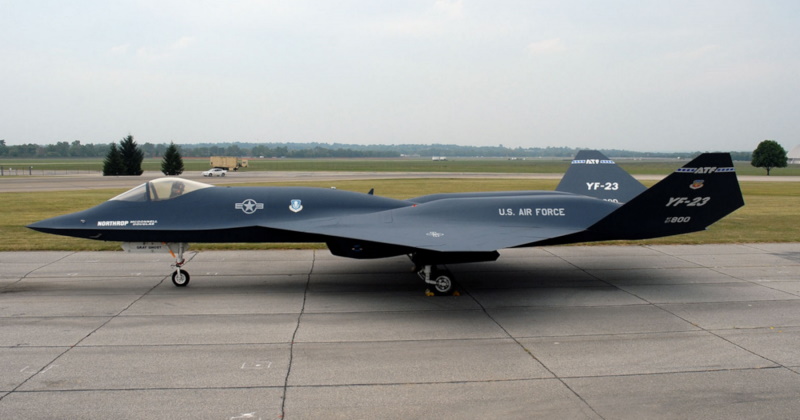
The YF-23A was unorthodox in appearance. The YF-23A was obviously a "stealth" design, with a diamond-shaped wing, a wide and flattened vee tail, engine exhausts hidden from view from below, a sawtooth rear fuselage across the tail and exhausts, and blended contours. The engine air intakes were underneath the wings, with the two engines buried well back from the inlets to keep them from reflecting radar signals. Air-to-air missiles (AAM), such as the AIM-9M Sidewinder and AIM-120 Advanced Medium-Range Air-to-Air Missile (AMRAAM), were to be carried in internal weapons bays, not externally. Such a design was clearly meant to give enemy radars very little to catch onto.
The YF-23A was 20.6 meters (67 feet 5 inches) long, had a 13.3-meter (43 foot 7 inches) wingspan, and a height of 4.27 meters (14 feet). The aircraft had a top speed of at least Mach 2.0 and supersonic cruise at about Mach 1.5. The YF-23A featured a "Vehicle Management System (VMS)" to keep it in the air. The VMS handled the YF-23A's flight control surfaces, including all-moving tailplanes and flaps on both the leading and trailing edges of the wings. The VMS could also monitor the aircraft's hydraulic systems, detecting and isolating damage to keep the fighter airborne.

* The Lockheed design, the "YF-22A", was rolled out on 29 August 1990, and first flew on 29 September. The aircraft was given the informal name of "Lightning II", after the famous Lockheed P-38 Lightning of World War II, but the name didn't stick.
The YF-22A had a more conventional configuration than the YF-23A, similar in broad plan to the current F-15 fighter: high-set cockpit, air intakes behind either side of the cockpit and extending to engines on either side of the fuselage, and twin tailfins. The YF-22A was less stealthy than the YF-23A, though more stealthy than the F-15. The YF-22A design was more optimized for maneuverability, with such features as thrust-vectoring engine exhausts that pivoted in the vertical plane.

* The YF-23A met USAF requirements for survivability, supersonic cruise, stealth, and ease of maintenance. However, the YF-22A was more maneuverable than the YF-23A, and won the competition in April 1991. Another factor was that the YF-22A was also seen as more adaptable to the Navy's NATF, though as it turned out the Navy abandoned NATF a few months later.
The engine selected for the winning YF-22A was the P&W F119, which was judged a lower-risk path. The contract specified that Lockheed provide seven single-seat F-22As, two tandem-seat dual-control F-22Bs, and two nonflying test examples. First flight of a true F-22 was scheduled for 1996, with operational introduction in 2003.
The second YF-22A prototype, powered by the P&W F119, quickly followed the first into the air. Although the first prototype was powered by two GE F120s, it was soon modified to take the P&W F119. Flight tests of the two YF-22A prototypes were augmented by avionics tests using a Boeing 757 configured as a flying laboratory. The 757 eventually acquired small sensor wings above the cockpit, a pointy nose with an AN/APG-77 radar, and small chines along the nose, giving it such cluttered lines that it was nicknamed the "Catfish".
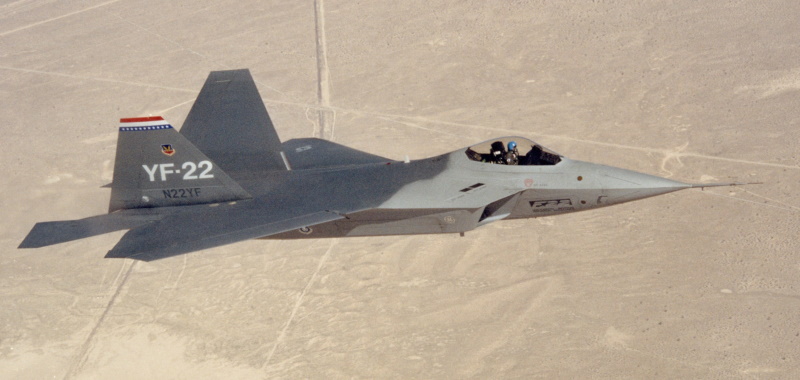
The flight tests went well until 1991, when one of the prototypes suffered a landing accident and was badly burned. The other prototype had been relegated to ground tests by that time, and neither of the two initial prototypes ever flew again.
BACK_TO_TOP* The YF-22A won the competition, giving the green light for the "engineering and manufacturing development (EMD)" phase of the program -- but the program was still confronted with obstacles. The main underlying cause of the uncertainty was the end of the Cold War, which greatly reduced the perceived military threat faced by the United States and called into question the need for highly sophisticated and expensive new weapons.
In 1990, US Secretary of Defense Dick Cheney lowered the planned production rate of the F-22 from 72 per year to 48 per year. The program continued to be whittled down, with the total production reduced from 750 to 648 in 1991, followed by a cut to a total of 442 in 1994. At this point, Lockheed began to feel the pinch between development costs and expected revenues. One Lockheed official, the late Ben Rich of the Lockheed Skunk Works, commented: "The sad truth is that our stockholders would have done better financially if they had invested ... in CDs."
Although the ATF had been originally intended as an air superiority weapon, in 1994 a modest secondary attack role was added to help protect the program. Despite such protective measures, the two-seat F-22B was canceled in 1997, and the total buy of F-22s was further reduced to 339.
The program still continued more or less on track. The first true F-22 prototype, more imaginatively designated the "Raptor", was rolled out at the Lockheed Martin plant at Marietta, Georgia, on 9 April 1997. There were numerous problems with the prototype, including software bugs and fuel leaks, and first flight was delayed to 7 September 1997. The second prototype first flew on 29 June 1998.
However, the pressures on the Raptor didn't go away. In the summer of 1999, faced with rising costs for maintaining military readiness and the burden of extensive military operations in the Balkans, Iraq, and elsewhere, the US House of Representatives moved to defer funding for the F-22. That led to a nasty political squabble, with one House appropriations committee staffer commenting: "The Air Force sent 25 guys up here to brief us on the need for the F-22 program, and they didn't impress us one damn bit." The Air Force managed to prevail in the debate, providing convincing arguments for their need for an "Air Dominance Fighter", as the F-22 was described.
On 15 August 2001, "low-rate initial production (LRIP)" of ten F-22s and 20 F119 engines was finally authorized, no doubt much to the relief of the program's backers. By late 2003, production standard machines were in evaluation. Operational introduction, with the USAF 27th Fighter Squadron, finally took place in 2005 -- not a bad delay, considering the ups and downs of the program.
BACK_TO_TOP* The F-22 was formally designated the "F-22A" -- but since there never was and never will be another F-22 production variant, it's just the "F-22". For a time, from 2002, it was referred to as the "F/A-22", the "A" standing for "Attack", as a means of emphasizing the aircraft's attack capabilities. However, when the machine was finally introduced to service, that subterfuge was dropped -- likely because it didn't fool anyone, and was possibly even counterproductive for a machine being promoted for its air superiority capabilities.

The F-22, as it emerged, had major similarities to the YF-22, but there were clear differences. The F-22's cockpit was moved forward, while the air intakes were moved back. The wings were clipped off and the rear control surfaces rearranged. The two tailfins were shorter, and the tailplanes were larger and reshaped. The main landing gear retracted sideways on the F-22, instead of forward.
The F-22 was made of titanium alloys (39% by weight); composites (24%); aircraft aluminum alloy (16%); and thermoplastics (1%). Advanced titanium welding techniques and composite fabrication were used in the aircraft's construction. "Radar absorbent material (RAM)" was used in critical locations to reduce the aircraft's radar signature, and the aircraft's contours were also intended to make it less conspicuous to radar. Apertures, such as weapons bay and landing gear doors, had zigzag edges to break up radar returns. An overall coating reduced the aircraft's infrared signature as well. While earlier stealth aircraft required substantial maintenance, careful handling, and protection from weather to keep them stealthy, the F-22 did not require extraordinary efforts to maintain its stealth characteristics.
The F-22's twin Pratt & Whitney F119-PW-100 engines could provide supersonic cruise without afterburner. The F119 had a high power-to-weight ratio (PWR) of 1.4:1, with each engine able to deliver 156 kN (15,900 kgp / 35,000 lbf) afterburning thrust. The F119 had a reduced parts count, and was designed for maintainability. Important components, harnesses, and plumbing were placed on the bottom of the engine to improve ground crew access, and all components could be removed or replaced with one of six standard tools. The digital engine control modules were redundant, with two controllers per engine and two computers per controller, to improve reliability.
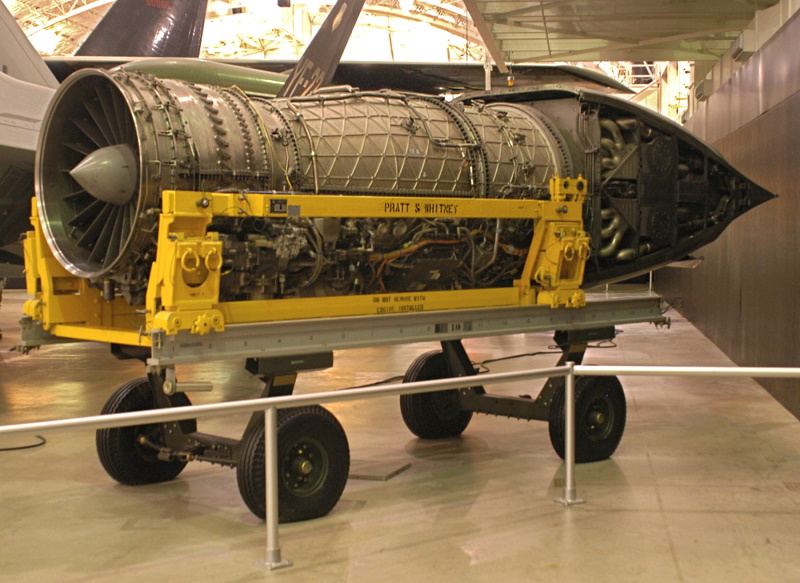
The F119 engine included thrust-vectoring exhaust nozzles that could traverse 20 degrees up and down to improve the Raptor's maneuverability in low-speed combat. The nozzles were automatically directed by the F-22's flight control system. The exhaust did not emit visible smoke under proper operating conditions, and provided a low infrared signature. Engine starting, as well as ground power, was provided by an auxiliary power unit (APU) turbine engine.
The F-22 featured eight internal fuel tanks, and there was a boom-refueling socket in the middle of the back. The internal fuel tanks were normally flooded with nitrogen to reduce the danger of fire from fuel fumes. The nitrogen was derived from the atmosphere by an on-board nitrogen generation system. The F-22 also included a fire-fighting capability, consisting of infrared and ultraviolet sensors linked to a fire extinguishing system.
The F-22 had a speed of Mach 1.5 in non-afterburning supercruise mode, and a speed of Mach 2.0 or above with afterburner. Flight tests demonstrated that the F-22 combined good handling characteristics with very high maneuverability. Pilots have described the F-22 as very pleasant to fly, combining the agility of an F-16 with the docile handling of the F-15, and the power of the aircraft made it, as one pilot put it, "a kick-ass rocket ship".
___________________________________________________________________
LOCKHEED MARTIN F-22 RAPTOR:
___________________________________________________________________
wingspan:
13.56 meters (44 feet 6 inches)
wing area:
78.04 sq_meters (840 sq_feet)
length:
18.92 meters (62 feet 1 inch)
height:
5.05 meters (16 feet 7 inch)
empty weight:
19,493 kilograms (42,974 pounds)
MTO weight:
36,288 kilograms (80,000 pounds)
max speed at altitude:
2,130 KPH (1,325 MPH / 1,150 KT)
supercruise speed:
1,810 KPH (1,125 MPH / 980 KT)
service ceiling:
15,000 meters (50,000 feet)
combat radius:
700 kilometers (430 MI / 375 NMI)
ferry range:
3,330 kilometers (2,070 MI / 1,800 NMI)
___________________________________________________________________
The pilot had an excellent view through the frameless canopy, which was designed to reduce radar reflections. A slightly modified version of the proven Boeing ACES II ejection seat, used on the F-15 and F-16, was fitted to the Raptor. The F-22 featured an "On-Board Oxygen Generation System (OBOGS)", eliminating the need to stock oxygen bottles.
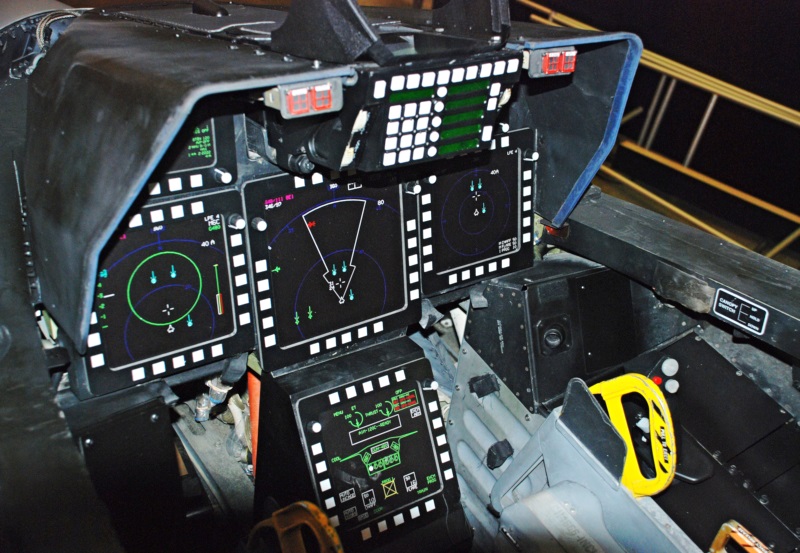
The cockpit control layout featured six high-intensity color liquid crystal panel displays, plus a wide-angle holographic "heads-up display (HUD)". The displays were functionally partitioned as follows:
The cockpit featured "hands on throttle and stick (HOTAS)" controls that allowed the pilot to execute command functions without letting go of the flight controls. Although the USAF's initial ideas for the ATF had envisioned "direct voice input (DVI)" controls, DVI was finally judged too risky and abandoned. DVI was something of a fad at the time; later experience with DVI in the consumer sector showed it had a number of limitations -- and though useful, was not quite as marvelous as it was played up to be.
* The F-22 included a single General Electric M61A2 Vulcan 20-millimeter Gatling cannon in the right wing root -- a thoroughly proven weapon, in operational service from the late 1950s. Ammunition store was 480 rounds, with a linkless feed system. The cannon was not fitted in the YF-22 prototypes. The Raptor also had three weapons bays, including a main weapons bay on the bottom of the fuselage, and a small weapons bay on the side of each air intake.

The main weapons bay could accommodate six AMRAAMs, or two AMRAAMs and bombs -- the AMRAAMs being the AIM-120C "compressed carriage" variant, designed with short flight surfaces to fit into the F-22's weapons bay. An AMRAAM was tossed away from the aircraft by a "Vertical Ejector Launcher (VEL)" before ignition. Typical internal bombloads included:
Each side weapons bay could accommodate a single AIM-9M Sidewinder missile, capable of "off boresight" attacks. The doors popped open, with the Sidewinder deployed out into the airstream at an angle to give its seeker a good field of view. The Air Force was slow to field the much-improved AIM-9X Sidewinder; it wasn't test-fired from an F-22 until 2015, and wasn't fielded until 2017. A helmet-mounted sight or "cueing system" is needed to make best use of the AIM-9X, but at last notice, the F-22 still doesn't have one.
The Raptor could also be fitted with a total of four underwing stores pylons for fuel or munitions, at the cost of the aircraft's stealthiness. The pylons were primarily intended to carry ferry tanks; they could be used for munitions as well, but the F-22 wasn't really intended for the strike mission. However, from 2022 Raptors flying as trials platforms have been observed carrying stealthy underwing pods. No particular care was taken to keep the pods from being seen by civilian observers who like to hang around the edges of test and trials facilities, but nothing has been said about them either. There have been conjectures that they could be used for electronic warfare gear, or to permit stealthy carriage of more stores, but nobody knows for now.
* The heart of the F-22's electronics capabilities was the "AN/APG-77" radar system -- which was updated in service, the current version being the improved "AN/APG-77(V)1". It was so much more than a radar that it has been labeled a "multifunction RF system" instead. With the AN/APG-77, the F-22 was able to detect an enemy aircraft's radar from distances of up to 460 kilometers (250 nautical miles). It could acquire an enemy aircraft at distances of up to 220 kilometers (125 nautical miles), while its "low probability of intercept" radar signals made it very difficult to detect, leaving the "stealthy" F-22 invisible to the enemy's radar. In many cases, an enemy will be hit with little warning.
The AN/APG-77 was built around an "Active Electronically Scanned Array (AESA)", which consisted of an array of about 1,500 transmitters-receiver (T/R) modules linked together by high-speed processors. The AESA could:
In principle, the AESA could do it all at the same time, simultaneously emitting several tight beams to perform different functions. Although the Air Force considered auxiliary side-mounted arrays for the AN/APG-77, they were abandoned due to cost, and the AESA was limited to a field of view 120 degrees across in the forward direction. Other antennas provided missile and radar warning behind the aircraft.
When operating as a radar, the AN/APG-77 transmitted waveforms that changed from burst to burst, and were sent at random frequencies. Such a "low probability of intercept" signal was very difficult for an enemy to detect and analyze, while the stealthiness of the F-22 made it hard to target. The AESA was also capable of analyzing enemy targeting radar, and sending out a jamming burst to disrupt the lock -- with the AESA going on to other tasks until the enemy radar began its lock cycle again.
Between dealing with active threats, the AESA could collect information on the "electronic order of battle (EOB)" in the operational area, using both radar and ELINT capabilities to locate electronic "emitter" systems, classify them, and alert the pilot to possible threats or high-priority targets. The AN/APG-77 was a pioneer in operational development of the AESA.
Other F-22 electronic and defensive subsystems included:
The Air Force has said little about the F-22's missile warning gear and active infrared defensive countermeasures. The F-22's avionics system also had a "non-cooperative target recognition (NCTR)" capability that obtained a "signature" of a target and compares it to a library of possibilities. The details of NCTR remain secret, though the latest iterations likely incorporate artificial intelligence (AI) technology, the system being "trained" to recognize different targets.
The F-22's avionics were designed to allow a single crewman to perform missions traditionally reserved for two-seat aircraft. Almost all electronics gear on board was integrated by two "Common Integrated Processors (CIPs)". The CIPs were based on commercial off-the-shelf electronics; they have evolved through a number of configurations as more computing power became available, the original CIPs being put to shame by any modern smartphone. The CIPs handled almost all the F-22's electronics functions, in particular assessing and prioritizing threats to display to the pilot. The CIPs provided a degree of self-test and reconfigurability that could keep the F-22 flying even with battle damage.
The entire F-22 was thoroughly wired for self-test. Almost every subsystem could check itself for faults and report its operational status. Ground crews could monitor the health of the aircraft through a laptop computer, configured as a "Portable Maintenance Aide (PMA)". The PMA could list faults and perform diagnoses, as well as check the level of consumables such as fuel and oil. Overall maintenance demands for the F-22 were estimated to be half or less that for an F-15.
BACK_TO_TOP* By the summer of 2008, 122 F-22s had been delivered. By then, the perception was increasingly that the Raptor wasn't exactly the right tool for the "dirty little wars" of the 21st century. It had been designed to counter fourth-generation Soviet air superiority fighters that hadn't materialized -- and though the Air Force wanted some insurance against the day when such a threat did appear, given the demands of existing struggles against insurgents and terrorists who had no air power at all, there was only so much insurance that made sense.
In early 2009, the decision was made to end production after delivery of 187 machines -- not counting eight prototypes -- with the last Raptor rolled out in late 2011. The F-22 finally had its baptism of fire on 23 September 2014, performing air strikes in Syria against Islamic State insurgents using GPS-guided munitions. Of course, this was ironic, since the Air Force regarded strike as only a secondary mission for the Raptor; there were with criticisms that it was overkill, too expensive for that mission. The response was that the area of operations was under the umbrella of Syrian air defenses, and a stealthy platform was the most appropriate one for the job.
The F-22 didn't score an air-to-air kill until 2023. On 28 January, a large Chinese balloon entered US air space over the Aleutians, to float through Alaska, Canada, and then into the USA. There was a noisy public fuss over it, but the White House didn't give the order to shoot it down until it was just off the coast of South Carolina -- the stated reason for the delay being that it might pose a hazard if it were shot down over a populated area. On 4 February, an F-22 dropped it with an AIM-9X; the aircraft doing the honors was given the callsign "Luke", after American World War I ace Frank Luke JR, who liked to shoot down German observation balloons.
An F-22 then shot down another floating object over Alaska on 10 February, followed by a third shoot-down over the Yukon the next day, at the request of the Canadian government. The wreckage of the balloon shot down on 4 February was recovered, while the wreckage from the other two shoot-downs disappeared into the wilds. The Chinese insisted the balloon shot down on 4 February was a stray weather balloon, with the Americans replying that it was actually a signals-intelligence platform. The nature of the other two balloons is not known.
* While the F-22 was, in some senses, a dead end -- production being terminated after only a moderate quantity was built, with no export sales -- Raptor pilots know just how good a fighter aircraft it is. Pete Fesler, a USAF F-22 wing commander, expressed no doubts on that score:
BEGIN QUOTE:
... In the F-22, I start it, and the aircraft is by and large testing all of its systems by itself. ... The amount of power in this airplane is incredible. We do not do afterburner take-offs because there is no reason to, even with 8,000 pounds of external fuel carried in drop tanks ...
... It was truly a mind-blowing experience for an F-15 guy stepping into that thing. I have a stealthy platform that can out-turn everybody, can out-run everybody, and it has better sensors. The F-22 put it all together. I can fly around the battlefield at Mach 1.5 in supercruise and just hang out there, being largely invisible.
... The thrust-vectoring will just kick the nose around to wherever you want it. In another airplane, you'd just depart from controlled flight. But that's just a small part of what this jet can do. Like, the first time you point at an F-15 or an F-16 from a hundred miles away, you can fly right by them, turn around, and come up to 3,000 feet behind in their "six", and know they never saw you.
... much of my time in the F-15 was spent trying to be the "fusion engine" -- to take the data from the federated systems, and build a three-dimensional picture in my mind, and then communicate it. In the F-22, the fusion is done for me, as I export the fused picture [via datalink] to other F-22s ... Do I have enough excess capacity that now I can do that for everybody else in the battlespace? For example, where should I send the F-15s, the F-16s, the F/A-18s? ... Go get those threats, and this is the best place for you. It's quarterbacking from a fighter cockpit -- in other words, airborne command & control from a fighter cockpit.
END QUOTE
There were no foreign users of the F-22, Congress having forbidden export of the aircraft. Not too surprisingly, the Japanese, and a number of other nations, have been evaluating their own advanced fighter designs, many of which clearly have a debt to the F-22.
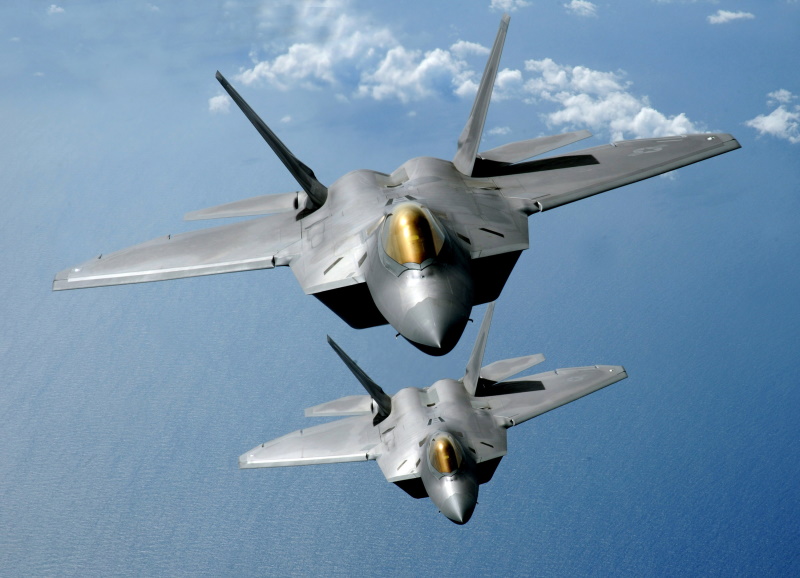
How much longer the F-22 will remain in service, nobody really knows. It is being given upgrades to keep it effective, including modernized software, with better sensor integration between the F-22 and the F-35 Lightning as a priority; improved radar and datalink capabilities; and, as per work begun by Lockheed Martin in 2014, a new RAM coating that lasts much longer than the old one. In 2021, an F-22 was observed by plane spotters, the aircraft being covered by a skin consisting of highly reflective metal tiles. The USAF said nothing about it, with speculations suggesting it was either a prototype of a new type of anti-radar skin, or possibly a specialized test configuration not intended for operational use.
The Air Force has no interest in obtaining any more F-22s. The service is now investigating a "Next-Generation Air Dominance (NGAD)" fighter to follow the F-22 in the 2030 timeframe, envisioning it as stealthier and more capable than the F-22. There's no point in putting an old fighter back into production if a better one can be obtained. The Air Force sees NGAD as a lever to change the paradigm of combat aircraft development, envisioning a modular approach that reduces lead times, with an evolving kit of subsystems that is continually updated.
* As a footnote, the USAF conducted a series of investigations towards a next-generation bomber to replace the B-1 and B-2 currently flying. At one time, there was consideration of a near-term "interim solution", with Lockheed Martin proposing a derivative of the F-22, the "FB-22", in response.
In refinement, the FB-22 concept used the fuselage of the F-22 mated to a new wing with about three times the area. The wing would be "wet", providing fuel storage that would triple the FB-22's unrefueled range compared to the F-22. The cannon would be deleted. The main weapons bays would be fitted with bulged doors to permit carriage of more or larger munitions, and the FB-22 could carry two to four stealthy underwing pods, raising the total load of SDBs from 8 to 35. It would also be able to carry heavier munitions and two AMRAAMs for self-defense.
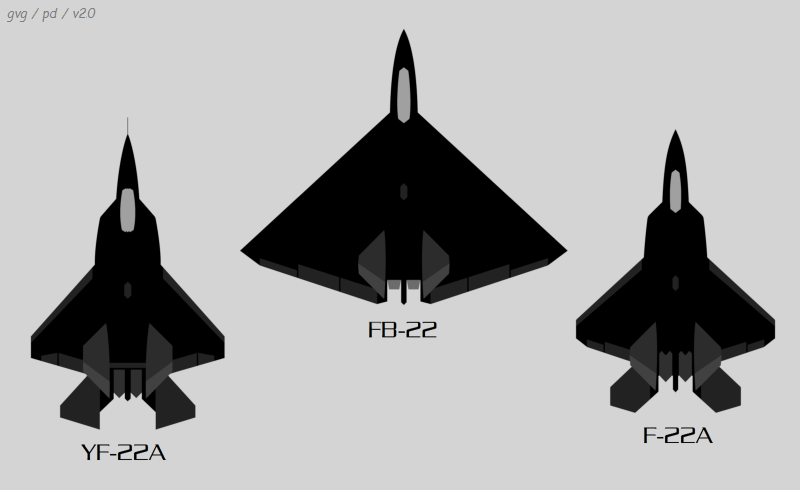
FB-22 avionics would be leveraged off F-22 avionics, with some enhancements as necessary or useful. The FB-22 would be fitted with improved F119 engines with more power and better fuel economy -- though without thrust-vectoring nozzles. The FB-22 would be capable of supersonic performance, but not supersonic cruise. The Air Force was after a two-seat configuration, which had already been designed for the canceled F-22B. Northrop Grumman also came up with an "FB-23" bomber derivative of the YF-23A, but neither the FB-22 nor FB-23 went anywhere, the USAF focusing on a next-generation flying wing, along the lines of a better and cheaper B-2 -- which emerged as the Northrop Grumman "B-21", to be fielded around 2025.
BACK_TO_TOP* The political controversy behind the F-22 has had some amusing aspects. At one time, program backers cited estimates that had been devised that gave the "kill ratio" between the F-22 and the MiG-21 as about a thousand to one in the F-22's favor. Even senior USAF brass responded, in essence, to ask them what they had been smoking. It brought up the old joke that fighter complexity and cost was increasing so rapidly that eventually the Air Force would only be able to buy one fighter -- but it would be able to destroy the entire Red Air Force by itself.
I finally saw an F-22 in flight in 2008 at an airshow. It put on a performance that as astounding -- it would do things that wouldn't have been controlled flight in almost any other aircraft, such as going into a climb, halting at the top of the climb, and then sliding back down along its flightpath.
* Sources include:
* Illustrations credits:
* Revision history:
v1.0 / 01 sep 99 v2.0 / 01 may 00 / Merged F-22 & JSF documents, added AESA details. v2.1 / 01 dec 00 / Added info on first flight of JSF candidates. v2.2.0 / 01 jan 02 / Broke out JSF materials, minor update. v2.2.1 / 01 jan 04 / Minor update and reorganization. v2.3.0 / 01 mar 05 / FB-22 comments. v2.3.1 / 01 feb 07 / Review & polish. v2.3.2 / 01 feb 09 / Review & polish. v2.3.3 / 01 aug 09 / Minor update, changed "F/A-22" to "F-22A". v2.3.4 / 01 jul 11 / Review & polish. v2.4.0 / 01 jun 13 / General streamlining. v2.4.1 / 01 apr 15 / Review & polish. v2.5.0 / 01 mar 17 / Substantial cleanups, updated details. v2.5.1 / 01 feb 19 / Review, update, & polish. v2.5.2 / 01 dec 19 / Review, update, & polish. v3.0.0 / 01 mar 21 / Review & reorganization. v3.1.0 / 01 mar 23 / Review, update, & polish.BACK_TO_TOP
